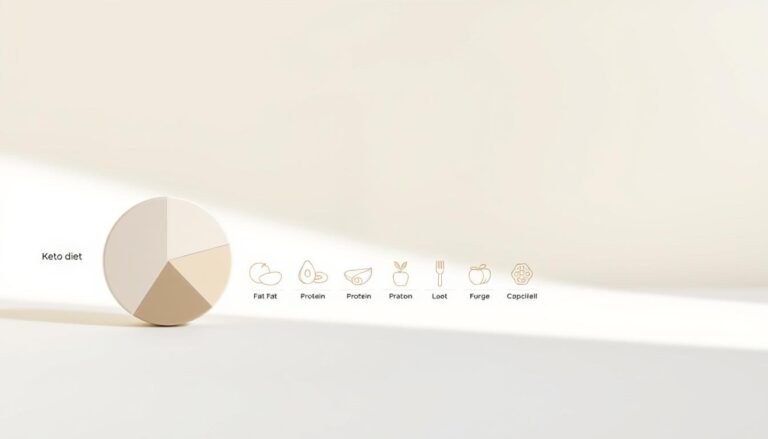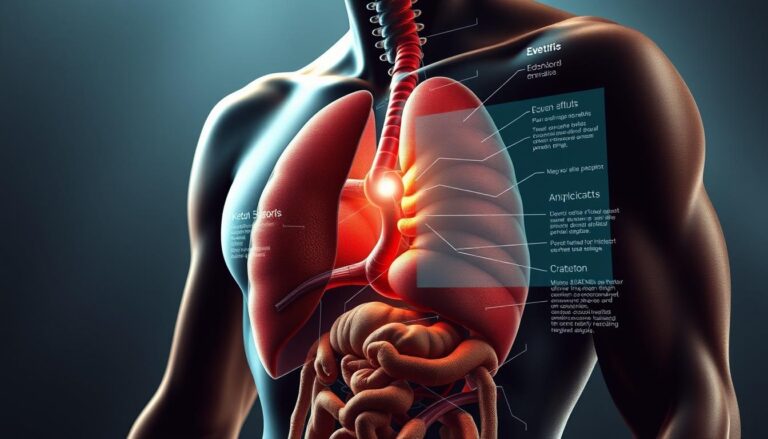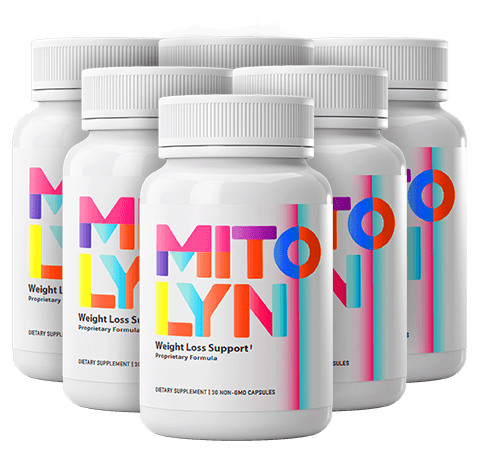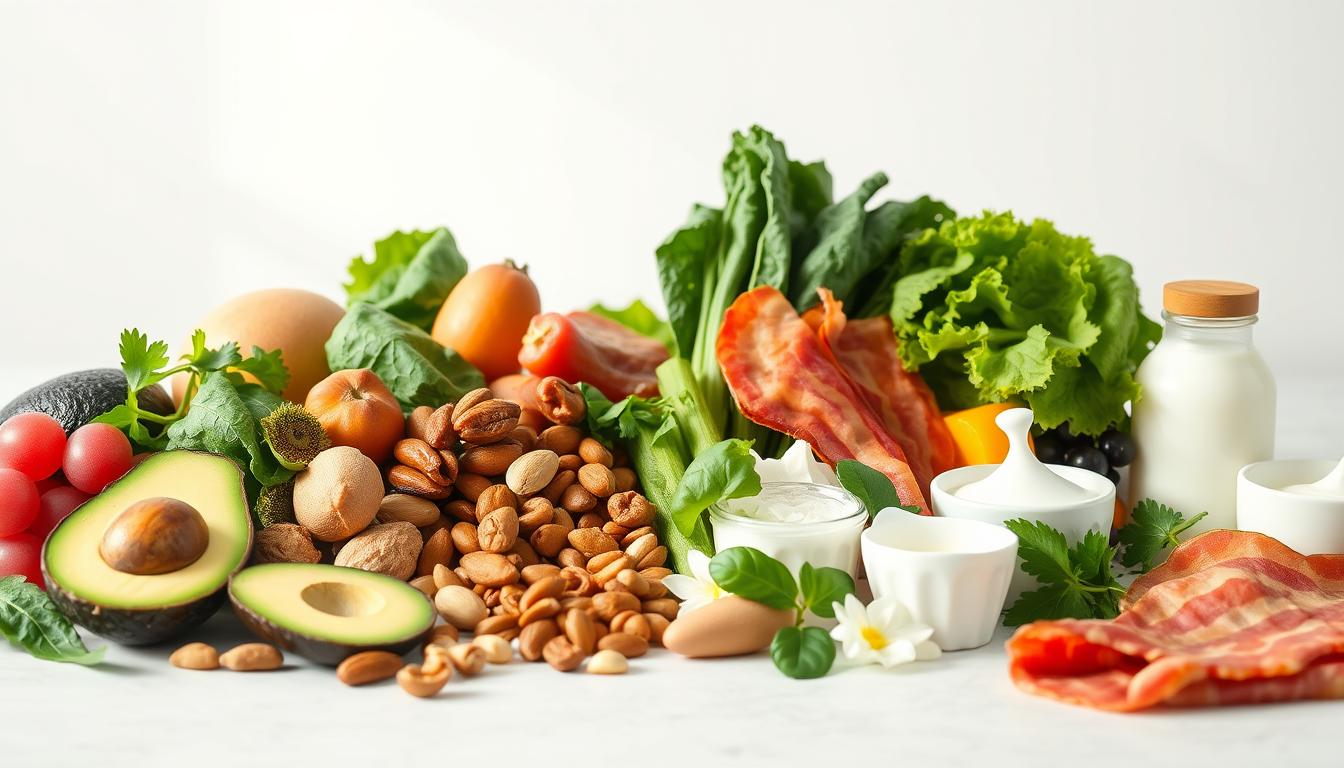
Two popular diets are keto and low-carb. The keto diet helps people lose weight and control blood sugar. Low-carb diets are more flexible with carbs.
Choosing a diet is important. The keto diet boosts energy and mental focus. Low-carb diets are flexible, fitting different needs. Each diet has its own benefits and drawbacks.
Understanding the Basics of Keto and Low-Carb Diets
To choose the right diet, knowing the basics of keto and low-carb diets is key. A keto diet definition means eating lots of fat, less carbs, and some protein. This helps your body enter ketosis. A low carb diet definition is about cutting carbs to lose weight and feel better.
The ketogenic diet science is complex. But simply, it’s about using fat for energy when carbs are low. This leads to weight loss and better blood sugar control. Knowing this science helps you pick the best diet for you.
What Defines a Ketogenic Diet
A ketogenic diet is all about high fat, low carbs, and some protein. You eat lots of fat from foods like meats, eggs, and oils. But you cut down on carbs from grains, sugars, and starchy veggies.
What Constitutes a Low-Carb Diet
A low-carb diet means eating less carbs to lose weight and feel better. You eat foods low in carbs, like meats, veggies, and healthy fats. But you avoid foods high in carbs, like grains and sugars.
The Science Behind Both Approaches
The science of keto and low-carb diets is complex. But it’s all about how your body uses energy. By understanding the ketogenic diet science and low carb diet definition, you can choose the best diet for you. This helps you lose weight and stay healthy.
The Fundamental Keto vs Low-Carb Differences
Understanding keto vs low carb differences is key. The keto diet and low-carb diet are not the same. They have different ways to help you lose weight and stay healthy. The main difference is in how much carbs you eat.
The keto diet is all about eating lots of fat, some protein, and very few carbs. This puts your body into ketosis. On the other hand, a low-carb diet just cuts down on carbs without aiming for ketosis. The big debate is how strict you should be with carbs, with keto diets being stricter.
Here are some main differences between keto vs low carb diets:
- Macronutrient breakdown: Keto diets are mostly fat, with some protein and very few carbs. Low-carb diets can vary more.
- Carbohydrate restriction: Keto diets limit carbs to 20-50 grams a day. Low-carb diets are more flexible.
- Overall approach: Keto diets aim for ketosis. Low-carb diets focus on cutting carbs for weight loss and better blood sugar.
In short, knowing the keto vs low carb differences helps you choose the right diet. Think about what each diet offers. Then pick the one that fits your life and health goals, whether it’s keto or low-carb.
| Diet | Macronutrient Breakdown | Carbohydrate Restriction |
|---|---|---|
| Keto Diet | 70-80% fat, 15-20% protein, 5-10% carbohydrates | 20-50 grams of net carbs per day |
| Low-Carb Diet | Varied macronutrient distribution | More flexible, but typically |
Carbohydrate Restrictions: How They Compare
Carbohydrate limits are key in keto and low-carb diets. Knowing the keto carb limits is vital for those starting a ketogenic diet. A keto diet usually allows 20 to 50 grams of net carbs daily.
Low carb daily allowances differ based on diet and personal needs. Some diets let you eat more carbs, while others are stricter. It’s important to track carbs for both diets to stay on track and make smart food choices.
Keto Carb Limits and Guidelines
Keto dieters must watch their carb intake to stay in ketosis. Keeping track of carbs is key. A food diary or carb counting app can help with this.
Low-Carb Daily Allowances
Low-carb dieters also need to monitor their carb intake. Their daily limits are a bit higher than keto dieters. Eating whole foods and avoiding sugary drinks and snacks helps stay within limits.
Tracking and Measuring Carbs
Tracking carbs is crucial for both keto and low-carb diets. Use a food diary, carb counting app, or read food labels. This helps make better food choices and stay within daily limits.
Protein and Fat Requirements
Understanding keto protein needs is key on a ketogenic diet. You should eat moderate amounts of protein. Too much can stop your body from going into ketosis. On the other hand, you can eat more fat, but choose healthy fats for better health.
A good ketogenic diet balances protein, fat, and veggies. Healthy fats like avocado, nuts, and olive oil give energy and help absorb vitamins. You can get protein from meat, fish, and eggs. For more protein, try protein supplements.
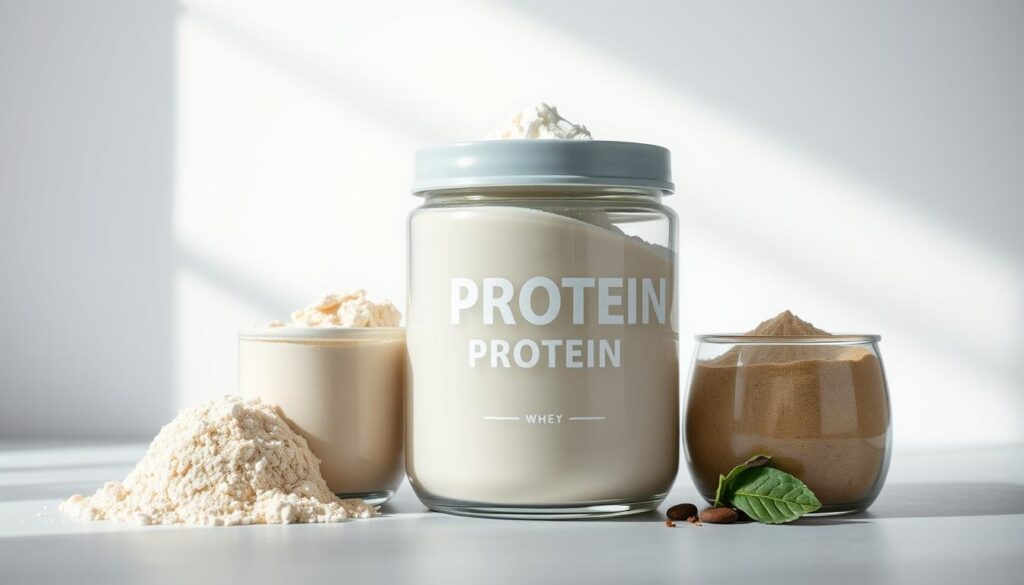
Here are some tips for meeting protein and fat needs on a low-carb diet:
- Focus on whole, nutrient-dense foods
- Incorporate healthy fats into meals and snacks
- Consider protein supplements if necessary
By knowing and meeting keto protein and fat needs, you can help your health and weight loss goals.
Impact on Your Body’s Metabolism
Understanding how keto and low-carb diets affect your metabolism is key. They change how your body uses ketosis vs fat burning. This affects metabolic adaptations and energy production differences.
These diets change how your body gets energy. Keto diets use ketones, while low-carb diets use glucose. This change can impact your health and weight loss.
Metabolic Effects of Ketosis
Ketosis makes your body burn fat for energy, not carbs. This can lead to metabolic adaptations like better fat burning and blood sugar control. Knowing the difference between ketosis vs fat burning helps you choose the right diet.
Comparison of Energy Production
The table below shows how keto and low-carb diets differ in energy production:
| Diet | Energy Source | Metabolic Effect |
|---|---|---|
| Keto | Ketones | Increased fat burning |
| Low-Carb | Glucose | Improved blood sugar control |
In summary, knowing how keto and low-carb diets affect your metabolism is crucial. By understanding ketosis vs fat burning, metabolic adaptations, and energy production differences, you can pick the best diet for you.
Weight Loss Effectiveness and Speed
When it comes to keto weight loss and low carb weight loss, how fast you lose weight matters. Both diets help with weight loss, but how quickly it happens can differ.
Keto weight loss might be quicker at first, with many seeing big weight drops early on. But low carb weight loss can last longer, helping people keep the weight off.
Things like how many calories you eat, what nutrients you get, and the quality of your diet affect weight loss. Adding things like intermittent fasting and intense workouts can also help with both diets.
- Eat plenty of protein to help with feeling full and keeping muscle
- Add healthy fats to support hormones and health
- Pick low-carb veggies and fruits for health and feeling full
Knowing what affects weight loss and using strategies to boost it can help. This way, you can pick the diet that works best for you and reach your weight loss goals.
| Diet | Short-term Weight Loss | Long-term Weight Loss |
|---|---|---|
| Keto | Faster | Variable |
| Low-Carb | Slower | More Sustainable |
Food Choices and Meal Planning
Food choices are key in keto and low-carb diets for a healthy weight. Foods like meat, poultry, fish, and healthy fats are important. Vegetables, nuts, and seeds add nutrients and fiber.
Meal planning is crucial for getting the right nutrients. With meal planning tips, you can make a diet plan that fits you. Plan meals ahead, shop for keto and low-carb foods, and cook healthy meals at home.
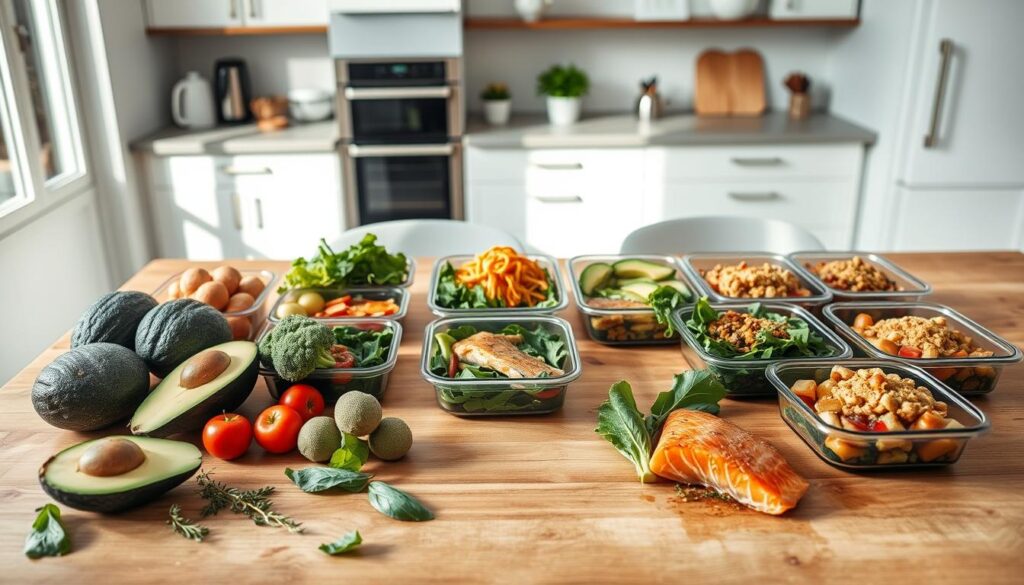
- Focus on whole, unprocessed foods like meat, fish, and vegetables
- Incorporate healthy fats like avocado, nuts, and seeds into your diet
- Choose low carb food options like leafy greens, broccoli, and cauliflower
- Use meal planning apps and cookbooks to stay organized and inspired
Follow these meal planning tips and add keto and low-carb foods to your diet. This will help you live a healthy and balanced life. Always talk to a healthcare professional or dietitian before changing your diet.
| Food Type | Keto Approved | Low Carb |
|---|---|---|
| Meat | Yes | Yes |
| Fish | Yes | Yes |
| Vegetables | Some | Yes |
| Nuts and Seeds | Some | Yes |
Health Benefits and Potential Risks
Thinking about a keto or low-carb diet? It’s key to know the good and bad sides. Both diets can help you lose weight and control blood sugar. But, they might also cause side effects. Knowing the pros and cons helps you choose wisely.
Keto diets can improve blood sugar and boost energy. Low-carb diets help with weight loss and heart health. Yet, both can lead to dehydration and electrolyte issues. It’s important to watch out for these risks and take steps to avoid them.
Keto diets can also cut down on seizures in people with epilepsy. Low-carb diets can improve blood fats. Both diets can reduce inflammation and clear your mind. To avoid risks, drink plenty of water, check your electrolytes, and talk to a doctor before starting.
Advantages of Each Approach
- Improved blood sugar control with a keto diet
- Weight loss and improved heart health with a low-carb diet
- Increased energy levels and reduced inflammation with both diets
Common Side Effects
- Dehydration and electrolyte imbalances
- Constipation and diarrhea
- Bad breath and fatigue
Long-term Health Considerations
On a keto or low-carb diet for a long time? Watch your blood fats, kidney health, and bones. Regular doctor visits are crucial. They help spot any problems and make sure the diet is safe.
Which Diet Fits Your Lifestyle
Choosing between a keto and a low carb lifestyle is important. Both have benefits but need different levels of commitment. A keto lifestyle means eating less carbs, which can be hard for those who love carbs.
A low carb lifestyle is more flexible but still needs careful planning. Think about your daily routine, work, exercise, and stress. A busy schedule might suit a low carb lifestyle better. But, if you prefer a structured diet, keto might be better. Remember, protein and fat intake are key in both diets.
Here are some things to think about when choosing:
- Carbohydrate intake: How much are you willing to reduce your carb intake?
- Protein intake: How much protein do you need to support your muscle mass and overall health?
- Fat intake: How much fat are you willing to include in your diet?
- Lifestyle habits: How will you incorporate exercise, stress management, and meal planning into your daily routine?

Finding a balance is key to success with either diet. With planning, tracking, and commitment, you can reach your health goals. Choose the diet that fits your lifestyle best, and you’ll be more likely to stick with it for the long term.
| Diet | Carbohydrate Intake | Protein Intake | Fat Intake |
|---|---|---|---|
| Keto Lifestyle | 20-50 grams per day | 0.8-1 gram per pound of body weight | 70-80% of daily calories |
| Low Carb Lifestyle | 50-150 grams per day | 0.5-1 gram per pound of body weight | 40-50% of daily calories |
Making the Transition: Getting Started
Starting a keto transition or low carb transition can feel scary. But, with the right steps, you can succeed. First, learn the basics of the diet. Then, plan how to start.
When you start, focus on cutting carbs and planning meals. A good meal plan helps you stay on track. Here are some tips to get you going:
- Track your carbs every day
- Plan your meals ahead of time
- Drink plenty of water and watch your electrolytes
Dehydration and electrolyte issues are common problems. They can make you feel tired and have headaches. But, with time and effort, you can beat these and reach your goals.
Knowing how long it takes to adjust is important. The keto transition usually takes a few weeks. The low carb transition might take even longer. Knowing this helps you stay motivated and focused.
| Diet | Transition Time | Key Considerations |
|---|---|---|
| Keto | 2-4 weeks | Carbohydrate restriction, electrolyte balance |
| Low Carb | 4-6 weeks | Gradual carbohydrate reduction, meal planning |
Conclusion: Choosing Between Keto and Low-Carb
When deciding between keto and low-carb diets, think about your health goals and lifestyle. Both diets have good points, but the best one for you depends on your needs and what you can keep up with.
If you want to lose weight fast, the keto diet might work better. It focuses on cutting carbs and burning fat. But, the low-carb diet is more flexible and easier to follow every day. The diet that fits your life is the one you’ll stick to.
Choose your diet wisely, but don’t get discouraged if it’s hard. Stay patient, keep going, and be kind to yourself. With the right attitude and healthy habits, you can reach your goals and feel better.







